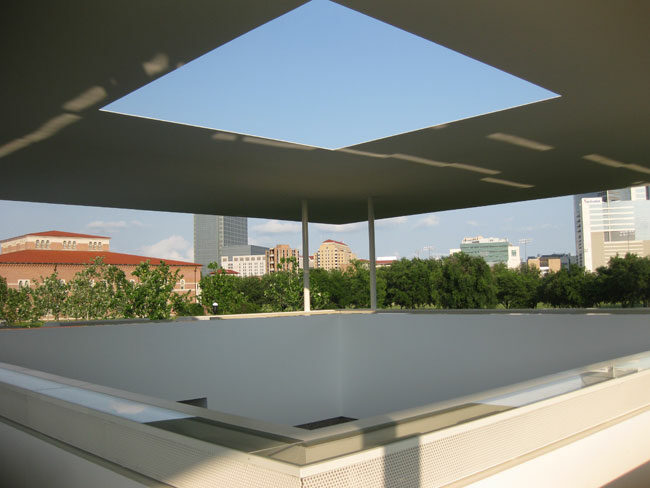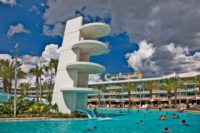Houston
Anchoring the western end of Rice University's main quad in Houston, James Turrell's new 118-foot-square Skyspace emerges from the earth (or lands from the heavens, depending on how you see it) in front of the monolithic Shepherd School of Music. “This is architecture that light and space makes,” explains the artist. When the sun illuminates the atmosphere, you can't see through it to view the stars that are there, he points out. “Light not only reveals, it also obscures—so you can actually build a space with it. I use light and architecture in that way: to limit space and to reveal it, either way.”
Dubbed Twilight Epiphany, Turrell's piece at Rice is composed of a 12-foot-8-inch-high grass berm that rises against the backdrop of the campus's neo-Byzantine brick academic quads. The truncated pyramid form, which employs a concrete structure below and steel columns above, is topped with a 72-foot-square conventional membrane roof with a steel-plate knife-edge and a 14-foot-square aperture at its center. A lower-level seating area accommodates 44 people and features the artist's trademark benches, made of Texas pink granite. Precast-concrete seating for 76 occupies the upper viewing area, where LEDs are installed for the two daily light shows programmed to correspond with sunrise and sunset. Made possible by a gift from Rice trustee and alumna Suzanne Deal Booth, who suggested the university work with Turrell, the Skyspace is the artist's first engineered for sound (he worked with the music school to develop the concept), and it will host a variety of performances, some specially created for the space.
Despite—or perhaps because of—Turrell's adroitness at building with light, the most ethereal of materials, the artist needed to be brought down to earth to actually realize his creation. And though the piece is first and foremost considered an artwork, “you have this thing you enter, so it is an architecture, and it's going to be legally treated as a building—I understand that,” says the artist, who admits he does not deal well with such realities as code, and was hoping to dispense with handrails and step lights in this case. Addressing the need for an architect, the university paired up Turrell with New York–based Thomas Phifer and Partners, a natural choice since the university had previous experience with Phifer. The match was not a hard sell for the artist: Turrell, who has worked with many different architects, says he designed Twilight Epiphany to respond to Phifer's airy Brochstein Pavilion, a few hundred yards down the quad. “I wanted it to have a feeling of mass that came out of its landform, but I also wanted to make this thin plane that floated in the sky,” he says. “I wanted to do a piece that offset Tom's—something that had a certain lightness, because his structure has this elegant lightness.”
“We took James's drawings and we turned them into something,” says Phifer, who has worked with numerous artists over the years and was happy to add Turrell to the roster. Not surprisingly, Turrell was very particular about the dimensions and scale of the room, the height the roof rose above the berm, the exact size of the opening, and the precision of the knife-edge, says the architect. “All of those details he's been doing for most of his life—it's a huge part of this work. The result is hypnotic. You're taken to another place.”
Phifer, known for the central role of light in his work and the precision of his own detailing, ensured that Turrell's intentions were preserved by finessing the technical aspects, such as stiffening the structure so it can stand up to hurricane-force winds, and preventing the roof's sharp edges from warping in the heat and humidity by using analysis to determine steel plate thickness (as well as specifying radiant barrier paint). And, of course, he tackled the code. It's all about managing these invasions so they do not become the focus. “It takes just one of those little moments to get jerked back to reality in a space like this,” notes Phifer. This shared understanding about the transformative potential of the built world underlies the strength of the pairing of artist and architect. “Though my work may not inform architecture, it can inform an architect about how we perceive,” says Turrell. “My interest is working in this space that we inhabit, which is not always the physical space that we have built.”
During the day, Twilight Epiphany gleams, a beautiful object offering an intriguing pause against the columned facade of the aggressively Postmodern Ricardo Bofill music school. As night falls, the colors projected on the levitating white canopy shift in juxtaposition to those in the sky. The frame brings passing objects into surreal focus—a cloud, a plane, a bug—and the walls dissipate, leaving you to consider the multitude of possibilities beyond.
PeopleOwner: Rice University Artist: James Turrell
Technical Architect:
Technical Architect Personnel:
Engineer(s):
MEPF Engineer:
Geotechnical Engineer:
Civil Engineer:
Consultant(s):
Lighting:
Acoustics/AV Consultant:
Specification:
Code:
Graphics:
General contractor: CAD system, project management, or other software used: ACAD Completion date: June 2012 |
Products
Exterior cladding EIFS, ACM, or other: Parex Moisture barrier: Tremco Stucco: Parex
Roofing
Windows
Glazing:
Doors
Hardware Exit devices: Locknetics Security devices: Security Door Controls
Interior finishes
Furnishings Speakers: Amina
Lighting:
Add any additional building components or special equipment that made a significant contribution to this project: Electrical Subcontractor: Capp Electric Steel Fabricator: Berger Iron Works Glazing/Misc Metals: Berger Iron Works Steel Erector: Milestone Metals, Inc Stone/Precast Installer: Dee Brown, Inc Stucco Installer: Baker Triangle Cast-in-Place Concrete: TAS Commercial Concrete Earthwork: AYG Construction, LTD Waterproofing: L.S. Decker Inc Roofing: Chamberlin Roofing and Waterproofing
|





















Post a comment to this article
Report Abusive Comment